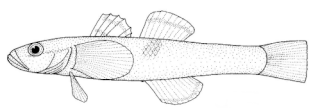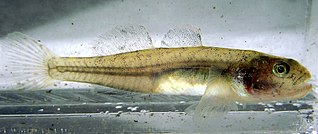
Mudskippers are any of the 23 extant species of amphibious fish from the subfamily Oxudercinae of the goby family Oxudercidae. They are known for their unusual body shapes, preferences for semiaquatic habitats, limited terrestrial locomotion and jumping, and the ability to survive prolonged periods of time both in and out of water.

Graham's gudgeon, Grahamichthys radiata, is a species of goby of the family Thalasseleotrididae, the only member of the genus Grahamichthys. This species is found in rock pools and in the neritic zone, to 50 metres (160 ft) in depth, where sand or mud is lies around and partially buries rocks, shells, or other objects. It is unusual for a goby, in that it lives in loose schools.

Eucyclogobius newberryi, the Northern tidewater goby, is a species of goby native to lagoons of streams, marshes, and creeks along the coast of California, United States. The Northern tidewater goby is one of six native goby species to California.

Exyrias is a genus of gobies mostly native to marine waters of the Indian Ocean and the western Pacific Ocean with one freshwater species (E. volcanus) known from the Philippines.

Odontamblyopus is a genus of gobies native to mud bottomed coastal and estuarine habitats from Pakistan eastward to Japan.
Odontamblyopus rebecca is a species of eel goby native to marine and brackish waters of Vietnam. This species can reach a length of 14.1 centimetres (5.6 in) SL. This species is mostly known from several specimens collected from a fish market in Haiphong, Vietnam.
The Kei goby is a species of goby native to marine and brackish waters along the coasts of Mozambique, South Africa, Madagascar and the Seychelles. This species can reach a length of 7 centimetres (2.8 in) TL.
Taenioides is a genus of gobies native to fresh, brackish, and marine waters of the coastal areas of the Indian Ocean and the western Pacific Ocean.

The yellow prawn-goby is a species of goby native to the Western Pacific, where it can be found at depths of from 1 to 25 metres in coastal bays and lagoons. This species is symbiotic with alpheid shrimps. The species can reach a length of 10 centimetres (3.9 in) SL. These fish vary greatly in appearance, ranging from brilliant yellow to gray and even brown forms or combinations of each coloring. This species is often kept in salt water aquariums. The yellow prawn-goby can be kept in aquariums as small as 20 gallons. In the marine hobby they are often partnered with tiger pistol shrimp.
Zappa confluentus, the New Guinea slender mudskipper, is a mudskipper endemic to New Guinea, where it is only known from the lower parts of the Fly, Ramu and Bintuni Rivers. It is found on mudflats adjacent to turbid rivers. This species can reach a length of 4.4 centimetres (1.7 in) SL.

Gobiodon histrio, the Broad-barred goby, is a species of goby native to the Indian Ocean from the Red Sea to the western Pacific Ocean to southern Japan, Samoa and the Great Barrier Reef. This species is a reef dweller, being found at depths of from 2 to 15 metres. It can reach a length of 3.5 centimetres (1.4 in) TL. This species can also be found in the aquarium trade.
Trypauchen vagina, commonly known as the burrowing goby, is a species of eel goby found in the Indo-Pacific region. It has an elongated body about 20 to 22 cm in length. It is reddish-pink in color and possesses distinctive pouches in the upper edges of its gill covers. It lives in burrows in the silty and muddy bottoms of its marine and brackish habitats. It has reduced eyes that are entirely covered with skin and the anterior portion of its head is protected by thick flesh. Both adaptations aid it in digging its burrows.

Trypauchen is a genus of burrowing gobies native to the Indo-Pacific region. It is classified under the subfamily Amblyopinae of the family Gobiidae. The name is derived from Ancient Greek τρύπα and αυχενος, referring to the distinctive opercular pouches of the members of the genus.

Amblyopinae is a subfamily of elongated mud-dwelling gobies commonly called eel gobies or worm gobies; it has been regarded as a subfamily of the family Gobiidae, while the 5th edition Fishes of the World classifies it as a subfamily of the family Oxudercidae. The members in the subfamily have two dorsal fins that are connected by a membranous structure and their eyes are highly reduced in size. They are usually pink, red, or purple in coloration.

Sicydium plumieri is a freshwater species of the goby native to the Antilles from Cuba to Trinidad and Tobago, though not recorded from all islands. This species can reach a length of 11 centimetres (4.3 in) TL. It is also known by the English common names sirajo, Plumier's stone-biting goby, and tri-tri goby. The young, which are regarded as a delicacy, are of commercial importance. The specific name honours Charles Plumier (1646-1704), a Franciscan friar and naturalist, who found the first specimens of the species on Martinique and Marcus Elieser Bloch based his species description on Plumier's drawings.

Istigobius is a genus of gobies found in fresh, brackish and marine waters of the regions along the coasts of the Indian and western Pacific oceans.
The peppered goby is a species of goby native to the waters around the Bahamas and Curaçao where it is mostly found inhabiting sponges, showing a particular affinity for Spheciospongia vesparia. This species is the only known member of its genus.
Trypauchenichthys is a genus of gobies native to fresh, brackish and marine waters along the Indian Ocean and Pacific coasts of Asia.

Istigobius ornatus, the Ornate goby, is a species of gobies found in the Indo-Pacific.

Oxyurichthys notonema, commonly known as the threadfin mudgoby, is a species of goby endemic to the Indo-West Pacific. This species reaches a length of 7.5 cm (3.0 in).












